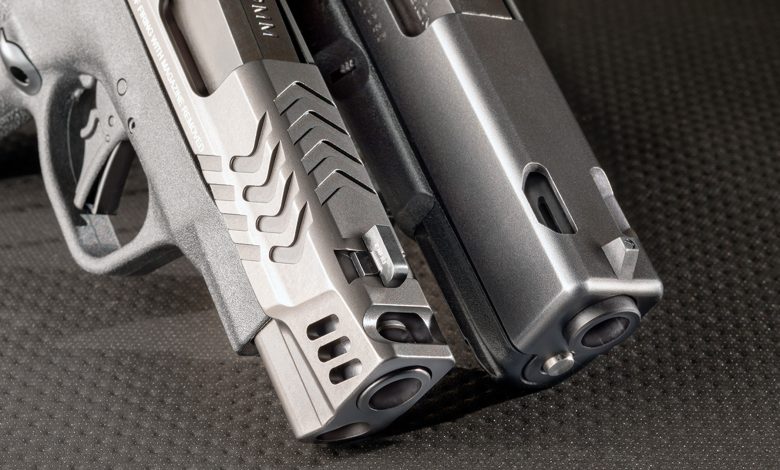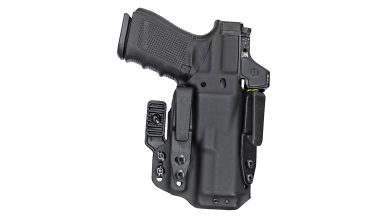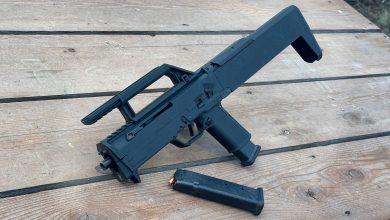A Brief Guide To Pistol Compensators

Various systems of using propellant gases to reduce muzzle flip and/or felt recoil in handguns have been around for a while.
In the 1970s and ’80s, Mag-Na-Porting became more common, especially on Smith & Wesson limited-run guns sold through distributors like Lew Horton. At the same time, compensated, 1911-pattern race guns grew to dominate certain types of action-pistol sports.
It really didn’t make a splash on the wider world of general handgunning until the 1990s, when Glock released versions of its pistols with recoil-reducing ports in the barrel. Glock advertised these with full-page ads on the back covers of most every gun mag at the time, and they showed a low-light photo of a Glock firing with a pair of jets of flame lancing upward from the ports on the barrel. Very dramatic.
The ports were visible through windows in the top of the slide, and I quickly traded the .40 S&W Glock G23 I was carrying at the shop back then for a ported Glock G23C. I toted it at work in a Bianchi PDQ holster, which was cut away in the front to show off the stylish high-tech porting.
The letter “C” in the model number stood for “Compensated,” which was something of a misnomer. The Glocks actually used porting rather than a compensator. What’s the difference? Glad you asked! That’s what this column’s here to explain.
Porting was popularized by Mag-Na-Port International, which was founded in Harrison Township, MI, by skilled machinist (and noted hunter) Larry Kelly, who had been using EDM machines to make, among other things, rocket-fuel valves for NASA’s Apollo rockets. So, yes, this is actually rocket science.
EDM, or electrical discharge machining, basically erodes metal with lightning, which is pretty cool. The stream of pulsing sparks can make a hole into the barrel, right into the rifled area, without leaving burrs or irregularities that would hurt the firearm’s accuracy. The EDM system also allows the machinist to vary the dimensions of the hole and, theoretically, give it a Venturi-type profile.
It turns out that on handguns, the volume and pressure of the jets from puny handgun cartridges and the short length of the handgun barrel minimize the effect that these vents have as little jet engines. Where the bulk of the recoil reduction comes from with porting is the force exerted by the gases on the front edge of the ports. They’re essentially diverting some gases to push the barrel forward and down, thereby counteracting the recoil and muzzle lift from the fired cartridge.
It’s really quite efficient. For a negligible velocity loss, no real increase in muzzle blast and zero reduction in accuracy, the measured free-recoil impulse can be reduced as much as 40 percent, depending on the chambering and load. Higher-pressure cartridges and ones with larger powder capacities will see a much larger reduction in felt recoil and muzzle flip.
Basically, on a 9 mm or .38 Spl. firing standard range loads, there won’t be a ton of benefit. On the other hand, the Mag-Na-Porting on my personally owned 4-inch Smith & Wesson Model 57 .41 Mag. makes a world of difference, especially with heavy loads.
The other type of recoil-reduction system commonly encountered is the true expansion-chamber compensator.
An expansion-chamber compensator on a semi-auto pistol is a separate device that attaches to the muzzle via threads or some manner of quick-detach fastener. Unlike porting, it does not intrude on the rifled portion of the barrel. (On revolvers and some pistols, the compensator may be integral, with the compensator area at the muzzle being counter-bored.)
It’s called an “expansion chamber” because the bullet exits the rifling and the gas is able to expand into this open area before being vented out anywhere between one and four ports. These compensator ports can be much larger than the small ones made by the EDM-porting machine, because they don’t have to worry about disturbing the rifling. The larger ports, then, offer much bigger surfaces for the gas to work against.
On the upside, an expansion-chamber compensator can have a noticeably larger recoil-reducing effect compared to porting.
So, why would anybody choose porting over a compensator? Well, the compensator isn’t without its downsides. Take a pistol known for its reliability, like a Glock G19, stick a threaded barrel and expansion-chamber comp on it and suddenly you’re looking around for ammo that cycles reliably. After all, the Glock is recoil-operated, and you just added a gizmo that bleeds off a lot of the energy that would otherwise operate the pistol’s slide. Ported guns generally suffer from this issue far less than their compensated kin.
Another problem is that the compensator must be removed and re-installed every time you fieldstrip the pistol for cleaning.
The added bulk of the compensator on the end of the barrel can complicate holster fit, too, although generally you can just use a holster intended for the next longer size pistol: a G17 holster for a comped G19, for instance. Lastly, the increase in apparent noise behind the gun is more noticeable with the compensator versus traditional porting.
In addition to the greater recoil reduction, however, the comp has another major advantage over simpler porting. The larger vents in the compensator act to diffuse the gases vented upward. They’re still noticeable, but less likely to be a major distraction when you are drawing and shooting from retention.
Further, when shooting from retention, the fact that the porting on a ported gun intrudes into the rifled portion of the barrel increases the odds of small lead or jacket shavings getting vented at high speed toward the shooter’s face. I’ve seen folks get the occasional brass freckle in a class when shooting from retention with ported pistols, a less-likely occurrence with a compensator.
One last old-wives’ tale I need to dispel, though …
It took some very clever photography for Glock to get that pic with the two little jets of flame. Any load in a ported pistol that generates enough muzzle flash to be noticeable like that, you can be certain that whatever comes out the ports won’t even be noticeable from behind the sights, because it’ll be swamped by the flash coming out the muzzle. Most quality self-defense ammo uses low-flash propellent, so you will be fine.
Read the full article here







